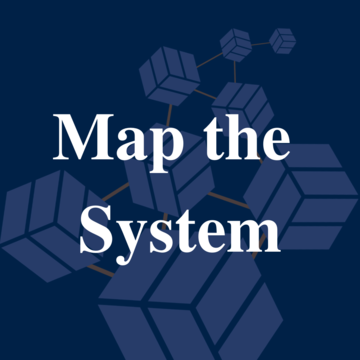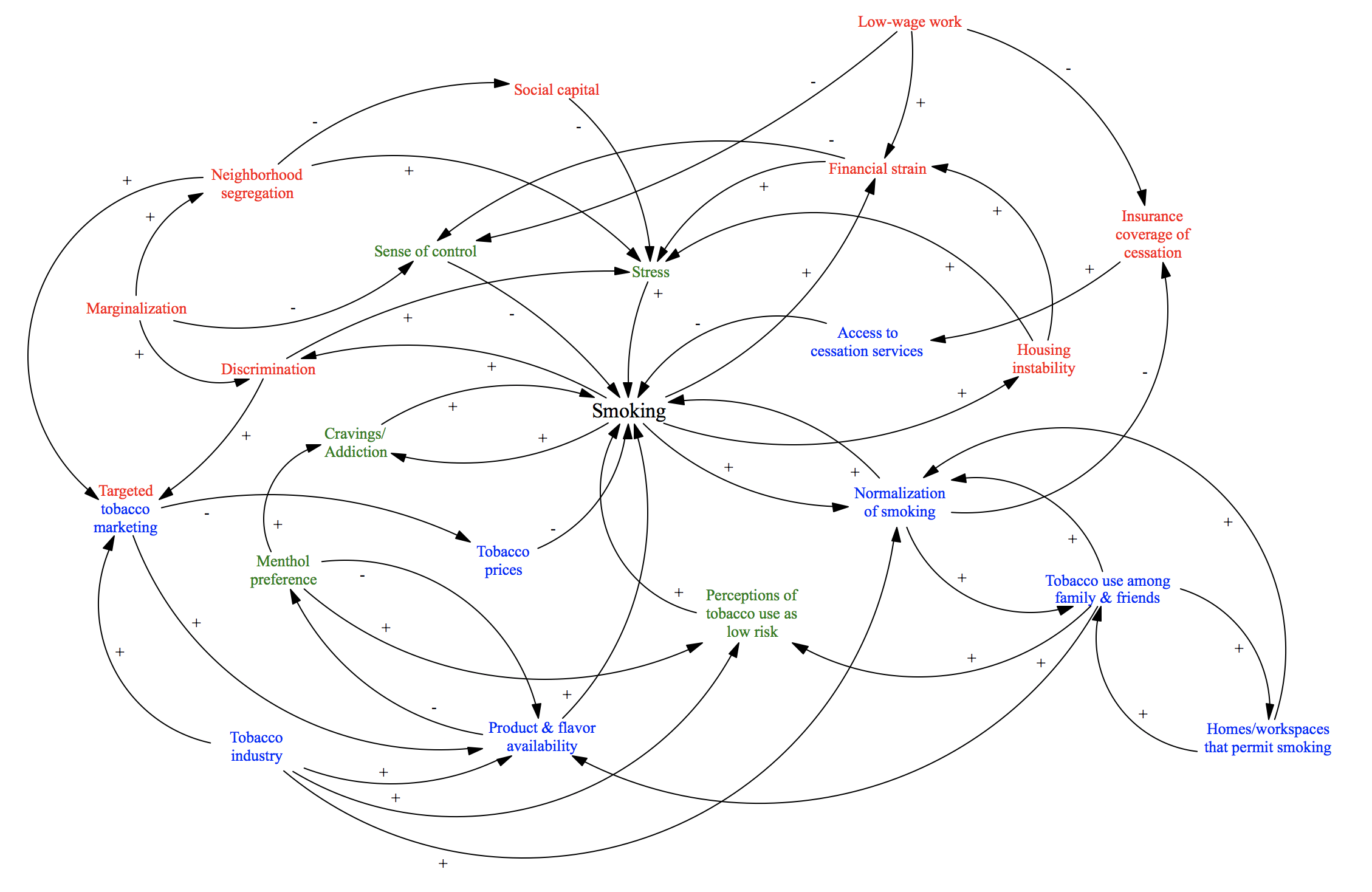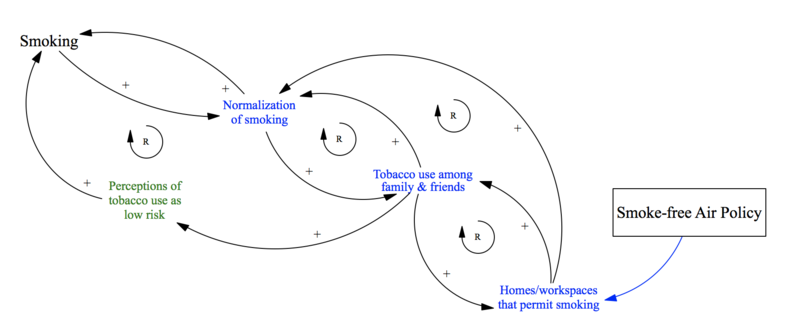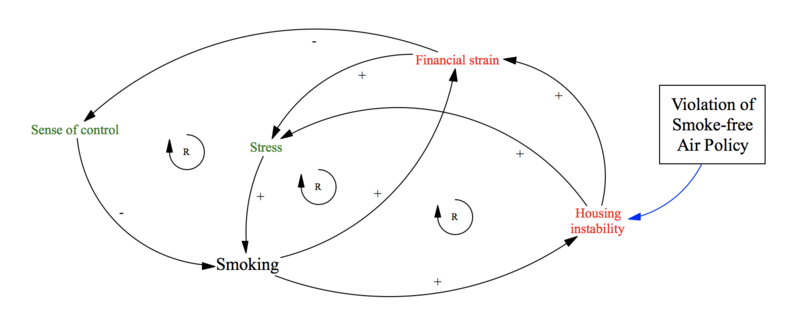Map the System: Using Systems Science to Advance Health Equity in Tobacco Control

Map the System: Using Systems Science to Advance Health Equity in Tobacco Control
On 15-17 June 2020, the Skoll Centre’s Map the System Competition held its Global Final virtually. The team from The University of North Carolina at Chapel Hill competed against 30 other finalists from institutions around the world at the event, coming in third place in the competition. Team members Meghan O’Leary, Paige Logan, Sarah Mills, Shelley Golden and Kristen Hassmiller Lich tell us how they mapped the system to explore inequities in tobacco control.
Smoking rates have declined considerably over the last five decades in the United States. However, this progress has not been shared equally. Many lower-income and racial/ethnic minority populations are more likely to smoke than their counterparts and disproportionately shoulder the burden of tobacco-related disease.
We created a team focused on understanding socioeconomic and racial/ethnic disparities in smoking from a systems perspective. Members of our team represent the fields of health behavior, health policy, and systems science. Building on these backgrounds, we developed a model that captures the multilevel factors affecting smoking. Processes of marginalization and segregation, as well as employment and housing factors that may produce financial strain, are included as key contributors to smoking in our model. By documenting these structural reasons for smoking disparities and lived experiences of people of color and lower-income groups, we hope our model can help to effectively engage communities and relevant stakeholders and to design tobacco control policies and programs capable of reducing smoking in priority populations.
Developing our model
Our model of smoking is informed by tobacco control literature and interviews with key stakeholders. We consulted prior research to identify factors associated with smoking. This included a close review of 12 prior smoking models – none of which addressed the specific factors contributing to higher smoking rates in priority populations. We turned to fundamental cause and social stress theories to identify these root causes of smoking among racial/ethnic minorities and lower-income groups.
We shared a model draft with nine stakeholders, who provided insightful feedback about our model, allowing us to consider new factors that should be included and challenging us to carefully consider the relationships between variables. They provided the perspectives of smokers, mental health professionals, health equity advocates, and community-based organizations.
Our smoking model

- Green = individual-level factors associated with smoking
- Blue = environmental-level factors associated with smoking
- Red = root causes of smoking among racial/ethnic minority and low-income populations
- + indicates the variables move in the same direction (e.g., as stress increases, tobacco use increases)
- – indicates the variables move in the opposite direction (e.g., as access to cessation services increases, tobacco use decreases)
Policy Implications
We applied our model to tobacco control policies designed to improve equity in tobacco control, revealing how the policies are intended to address disparities, as well as their potential unintended effects that may sustain or worsen disparities. For example, smoke-free public housing aims to lower smoking among public housing residents by creating more smoke-free homes and reducing pro-smoking norms. Yet, violation of this policy may result in financial strain and/or housing instability, increasing stress and reducing feelings of controls, which can lead to increased smoking. The figures below illustrate these intended and unintended effects.

Figure 1. Expected Impacts of the Smoke-free Air Policy
Reinforcing loops in the model are indicated with an ‘R’ and represent relationships that will continue to grow, or reinforce, over time.

Figure 2. Unintended Impacts of the Smoke-free Air Policy
We identified two other disparities-focused policies with potential unintended consequences per our model:
- A menthol ban intends to reduce smoking among those who prefer menthol cigarettes. However, targeted marketing of other tobacco products is still possible through segregation and discrimination.
- Minimum price laws (MPLs) enact the largest price increases on the least expensive tobacco products. While expected to reduce smoking by raising prices, this policy may unintentionally increase financial strain and stress and reduce feelings of control.
Our Recommendations
1. Use a health equity lens
Tobacco control efforts often focus on reducing smoking at the population level, but to ensure equitable outcomes, attention to priority populations is needed. Being intentional and focusing on how systemic racism and other structural factors permeate the model pathways and contribute to smoking disparities is critical. Future tobacco control efforts must acknowledge and address these lived experiences of communities.
2. Consider the intended and unintended consequences of tobacco control policies and programs
Well-intentioned efforts to lower smoking in priority populations can have unintentional and even counteractive effects. Consideration of these adverse outcomes upfront, as well as ongoing evaluation of policies and programs, can help to identify, react to, and address these unwanted effects.
3. Engage diverse types of stakeholders in tobacco control efforts
Additional voices are needed to represent the needs and perspectives of priority populations. We recommend engaging smokers, retailers, housing officials, law enforcement, social service agencies, mental health practitioners, and community-based organizations. Partnering with local communities can help to identify other relevant stakeholders.
Next Steps
Map the System provided a platform to present our model of smoking and receive feedback from other systems thinkers working on similarly complex issues. We value the information learned and are committed to continuing this work. We are currently conducting additional stakeholder interviews. We hope to build confidence in our model by testing some of the relationships between variables through future studies, and use our model to facilitate collaborative discussions about tobacco control in diverse populations.



